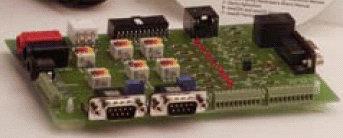Device profile: Owasys wireless remote management terminals
Jul 10, 2003 — by LinuxDevices Staff — from the LinuxDevices Archive — 38 viewsOwasys has developed a pair of Linux-based wireless terminals for remote management applications in automotive and industrial environments. The automotive model (Owa22A) can be used for fleet management, automatic vehicle location, emergency and theft monitoring, in-car telephony, onboard telematics, and vehicle positioning services. The industrial model (Owa22I) allows wireless-enabling a broad range of industrial equipment, such as providing remote access to vending machine stock levels. Both units provide built-in GSM/GPRS communications with IP capabilities, enabling efficient information transmission over the cellular wireless network, and the automotive model also includes a built-in GPS receiver.

Since the terminals provide IP connectivity, status and other information associated with equipment or peripherals connected to them can be made instantly accessible anywhere in the world via the Internet. Additionally, the software applications on the units can be updated remotely, via the GSM/GPRS network, thereby allowing the devices to be updated “over the air” while they are installed and running in the field.
Both wireless terminal models are powered by a 70MHz 32-bit ARM7 RISC embedded processor, and both use Linux kernel 2.4.18 as the basis of their embedded software platforms. 2MB of RAM and 1MB of Flash memory is available for user applications and data. Other key hardware features include . . .
- GPRS and dual-band GSM (900/1800 MHz)
- RS232 and RS485 serial ports
- CAN (controller area network) field-bus
- Odometer
- Audio in/out
- Data acquisition and control I/O: analog inputs; PWM outputs; digital I/O
- Optional internal backup battery (Li-Ion, 400 mAh)
- Integrated GPS receiver (in automotive version)
- Operating temperature: -25 to +55 deg. C with GSM; -40 to +70 deg. C (not fully compliant)
Experiences with embedding Linux
We asked Owasys to comment on why they selected Linux as the embedded operating system for the Owa2X Family wireless terminals, what their experience using it was like, and how they felt about its future in the embedded market.
“We chose Linux because it is an open, standard, well documented, and powerful software platform for developing any application in the embedded world,” recalled Cesar Sanchez, product manager for the Owa2X family. “Also, Linux is very robust, there is a lot of free software available, and there are no royalties.”
“Open gives us the flexibility to adapt and to optimize our products in order to maximize their performance,” Sanchez explained.
“Standard means that most of the software developers know quite well how to design for this OS, and the GNU development tools are well known,” he continued. “The development team doesn't have to learn a new software platform, for example new compilers, tools, the way the OS works, and other tricky OS stuff. Instead, they can spend their time focusing on the functions they are going to use, and on the project itself.”
“Well documented, because there is a huge amount of information available on the Web explaining how Linux works, including how every component inside it works. This aspect of Linux is really important. Linux is supported by a big team of people all over the world, the Linux community — but if you want to pay for support you can; there are a lot of companies offering that.”
“I think the power of Linux is well known to everybody,” said Sanchez.
“We are really glad we used Linux, and we want to continue using this OS for all the applications that requires an OS having such characteristics,” Sanchez added. “We support the peripherals that are inside our products. Apart from the applications, we have developed the drivers that were needed, and we have modified the kernel to fit our requirements. We did not need to port the kernel to our microprocessor, because we were able to use an ARM port that already existed when we started our project.”
“Years ago, it was difficult to imagine using Linux inside an embedded machine, due to the limited capabilities of microcontroller. But nowadays, the increased power of current embedded systems has made it possible,” Sanchez noted. “Linux is becoming the operating system for the new generation of embedded devices. Other OSes may still have a piece of the market in some specific products, but in our opinion, in the near future Linux will be the dominant operating system for the embedded world.”
Development kits for application development
Owasys offers a pair of development kits for the two terminals, to assist developers in creating customized applications to run on the systems. Among other things, the included software implements an application programming interface (API) for functions such as basic platform configuration, GSM/GPRS functions, Internet connection, and controlling its input/output interfaces. The kits include the Owa22A or Owa22I terminal, power supply, cables, antennas, developer board (shown below), and a CD with software and documentation.

Owa2X Developer board
This article was originally published on LinuxDevices.com and has been donated to the open source community by QuinStreet Inc. Please visit LinuxToday.com for up-to-date news and articles about Linux and open source.